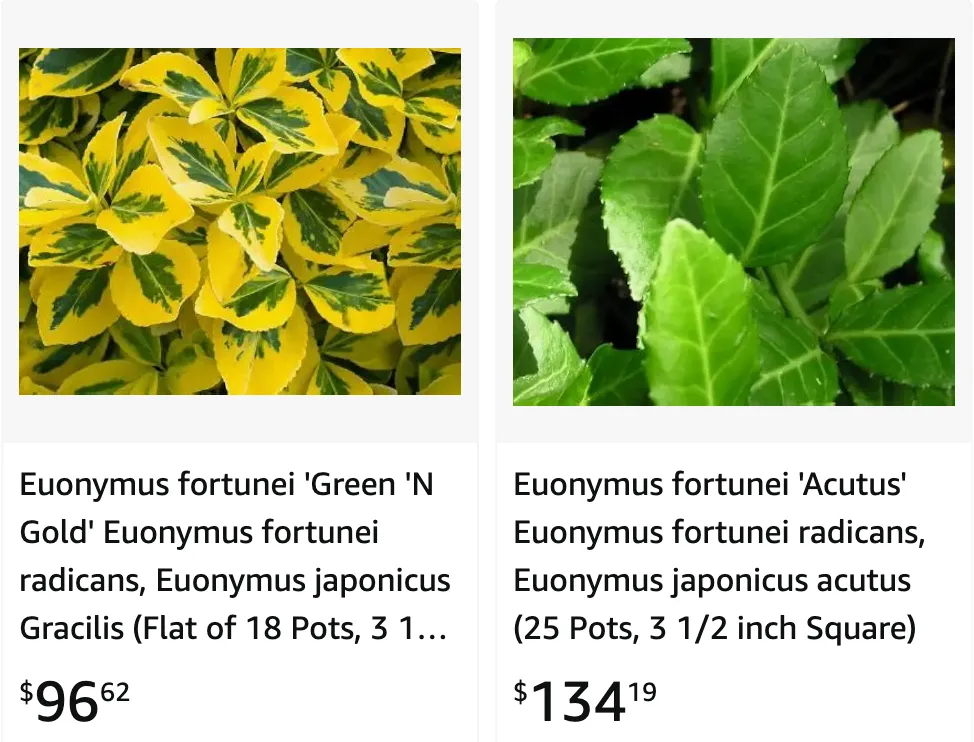
145 Species in Genus Euonymus
What is Euonymus Fortunei?
Euonymus fortunei, also known as Wintercreeper, is a versatile, evergreen plant native to East Asia. It’s loved for its vibrant green foliage, which often has a variegated pattern, and its ability to grow as a ground cover, shrub, or climbing vine. This plant thrives in various conditions and is commonly used for landscaping due to its adaptability and low-maintenance nature.
How to care for Euonymus Fortunei?
To care for Euonymus fortunei, plant it in well-draining soil in a location that receives partial to full sunlight. Water it regularly, especially during the first growing season, to establish its root system. Once established, it’s drought-tolerant. Prune it annually to maintain its shape and remove any dead or diseased branches. Fertilize in spring with a balanced fertilizer to encourage healthy growth.
How to propagate Euonymus Fortunei?
Propagating Euonymus fortunei is straightforward. You can propagate it through stem cuttings in late spring or early summer. Take a cutting about 6 inches long from healthy growth, remove the lower leaves, and dip the cut end in rooting hormone. Plant the cutting in a pot with well-draining soil and keep it moist until roots develop, usually within a few weeks.
Is Euonymus Fortunei invasive?
Yes, Euonymus fortunei is considered invasive in some regions, particularly in the United States. It spreads rapidly by producing seeds and rooting where its stems touch the ground. Its aggressive growth can outcompete native plants, so it’s essential to manage its spread if you’re growing it in areas where it is invasive.
Is Euonymus Fortunei poisonous to dogs?
Yes, Euonymus fortunei is toxic to dogs. If ingested, it can cause symptoms like vomiting, diarrhea, and lethargy. It’s advisable to plant it in areas that are inaccessible to pets or choose alternative plants if you have curious pets.
When to prune Euonymus Fortunei?
Prune Euonymus fortunei in late winter or early spring before new growth begins. This timing helps the plant recover quickly and encourages healthy, compact growth. Regular pruning can also prevent the plant from becoming too leggy or invasive.
Is Euonymus Fortunei deer-resistant?
Yes, Euonymus fortunei is generally deer-resistant. While deer may occasionally nibble on it, they typically avoid it due to its tough, leathery leaves and bitter taste. However, no plant is entirely deer-proof if food is scarce.
Can you grow Euonymus Fortunei indoors?
Yes, you can grow Euonymus fortunei indoors in containers. Ensure the plant receives bright, indirect sunlight, and use a pot with good drainage. Avoid overwatering, as this plant prefers slightly dry conditions indoors. Prune regularly to maintain a manageable size.
What are the benefits of growing Euonymus Fortunei?
Euonymus fortunei is highly versatile and offers several benefits. It serves as excellent ground cover, prevents soil erosion, and provides year-round greenery. Its climbing ability makes it ideal for covering walls and fences. Additionally, it’s low-maintenance and adapts well to various soil types and conditions.
What to plant with Euonymus Fortunei?
Euonymus fortunei pairs well with shrubs like boxwood or hydrangeas, which complement its dense foliage. It also looks great alongside flowering perennials such as coneflowers or black-eyed Susans, creating a dynamic contrast in texture and color.
What are the common problems with Euonymus Fortunei?
Common problems with Euonymus fortunei include powdery mildew, scale insects, and spider mites. Overwatering can lead to root rot, so ensure the soil is well-draining. Regular pruning and monitoring can help prevent these issues from becoming severe.
How does Euonymus Fortunei compare to similar plants?
Euonymus fortunei is often compared to other evergreen ground covers like ivy or pachysandra. Unlike ivy, Euonymus fortunei is less aggressive and easier to manage. Compared to pachysandra, it offers more diverse growth forms, including climbing and shrub options, making it more versatile for landscaping.
If i die, water my plants!



